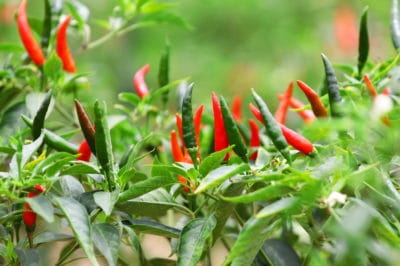All About Thai Chilis
This heirloom pepper takes 90 days to fully mature and is a perennial in USDA zones 10 and above. In cooler climates, it can be grown as an annual or overwintered indoors. The plant pumps out hundreds of small tapered chili that turn a fire engine red when ripe.
The color is a warning for the mighty punch this chili packs. On average, Thai chili peppers are about 23 times hotter than a jalapeno. They rank between 50-100,000 Scoville units.
Planting
In tropical zones, learning how to grow chilis is as easy as putting your first seeds in the ground. Plant chilis outdoors in a prepared garden space at any time of the year. Make sure the area is weed free, well-draining, and amended with plenty of rich compost as fertilizer. Seed can be broadcasted and then starts thinned later, or you can sprinkle it in rows. Top the rows with 1/4 inch of soil, seeds should sprout in 7-10 days.
In cooler zones, start Thai chilis indoors 8-12 weeks before your last frost. They may take 90 days to reach maturity, but you want them to mature as early as possible so they can pump out more fruit.
Plant them in seed blocks or four-inch pots and keep them somewhere where the temperature does not get below 60°F (15°C). Use a fluffy peat or coir-based potting soil to start the seeds amended with Perlite for water retention.
Thai Chili Planting Guide:
- Peat or coir based potting soil
- Keep seeds and seedlings at no lower than 60°F (15°C)
- Bottom water as opposed to top watering
- Position under fluorescent lights upon sprouting
- Acclimate before transplanting
- Transplant when soil temperatures reach 65°F (18°C)
Seedlings
When seedlings sprout indoors, immediately put them under fluorescent lights. The lights should be inches from the tops of the plants and you should have the ability to raise them as the plants grow. This will give the plant a thick, strong stalk to support itself with.
If possible, avoid watering from the soil surface. You’ll get better results and fewer problems by bottom watering. Acclimate and transplant seedlings outside when soil temperatures reach a consistent 65°F (18°C).
